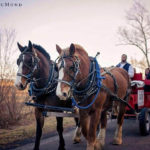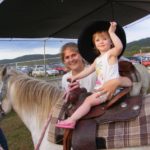
Fraser Fir
Also known as “Southern Balsam,” this stately fir, native to the Great Smoky Mountains of western North Carolina and eastern Tennessee, is closely related to its northern counterpart. Its soft, emerald-green needles with silvery undersides are about three-quarters of an inch in length. Its bottlebrush texture, sturdy branching, and outstanding needle retention make it a superb Christmas tree. It has become the most popular Christmas tree in recent years.

Douglas Fir
First studied by Scottish botanist, David Douglas, in the 1820’s, this conifer is widely distributed throughout western North America from the interior lake country of British Columbia to the mountains of Mexico. Found in the central Rockies, the hardy “blue” strain is widely used as a Christmas tree in the Northeast. Its lush, blue-green foliage, with needles about one inch in length, is very attractive. Its sturdy branching and outstanding needle retention make this evergreen a holiday favorite.

Concolor
Most commonly known as White Fir, this evergreen is widely distributed throughout the southwestern United States, from the Rockies of Colorado and New Mexico in the east, to California’s Sierra Nevada range in the west. Its soft, silvery-blue foliage, with flattened needles about two to three inches in length, has a distinctive citrus aroma. Its outstanding color and excellent needle retention make it an increasingly popular Christmas trees.

Canaan Fir
Found widely within the Canaan Valley of northeastern West Virginia, this tree is a genetic variation of traditional Balsam Fir. Native also to Pennsylvania and New York where it can be found in remote stands, its range extends as far north as Sheet Harbour, Nova Scotia. Although similar in appearance to the traditional sources, its needles tend to be longer, about one inch in length, and vary more in color. Its foliage, however, can often retain the bottlebrush appearance of Fraser Fir, its southern counterpart. Relatively new to the Christmas tree industry, its popularity continues to rise.

Balsam Fir
Balsam fir is a beautiful pyramidal tree with short, flat, long-lasting, aromatic needles. Balsam fir and Fraser fir have many similar characteristics and some botanists consider them extensions of the same species. Their geographic ranges do not overlap and the Balsam fir has to have cold winters and cool summers. Balsam fir has a nice, dark green color and is very fragrant. The tree was named for the balsam or resin found in blisters on bark and which was used to treat wounds in Civil War. Its dark green color, fragrance and great needle retention make it a superb Christmas tree.

Blue Spruce
Found throughout the central Rockies, this spruce borrows its name from the Centennial State and has stout, three-sided needles about three-quarters of an inch in length. Its foliage can vary in color from dark green to indigo blue. Its sturdy branching and good needle retention make it a desirable Christmas tree, while its excellent form and outstanding color make it the premier ornamental evergreen.
Tree Care Directions
Fresh Cut: Just like flowers, the fresher the cut, the longer your tree will last. If possible, it is best to slice 1/2 inch off the bottom of the tree just prior to putting it in water. (The hole drilled in the stump for pin stands is deep enough to allow this.)
Keep it Watered: Drinking water keeps the trees needles where they belong, on the tree! It also keeps your tree smelling fresh and reduces flammability. If your tree runs out of water even once, sap will close the pores and it will no longer be able to drink! Your tree will drink a lot more during its first few days in your house, until it becomes acclimatized.
Location: Try to avoid placing your tree in direct sunlight, hot rooms, or near heat sources such as ducts, radiators, or fireplaces.
Storage: If you are not putting your tree up right away, it is ok to leave it baled up. Please try to keep it in a cool place such as the garage, out of direct sunlight, and in water (with a fresh cut of course!)
Air Temperature: Thermal shock can cause early needle loss if the outside temperature is more than 40º lower than in your house when you bring the tree home. It is best to keep the tree in a moderate temperature for a few hours or even overnight before bringing it all the way inside. A protected place such as a covered porch or garage is suggested.
We hope your tree lasts as long as you want it too! We recommend placing a tree disposal bag under the stand prior to putting your tree up, to help contain any needles that fall as you take it down at the end of the season.









